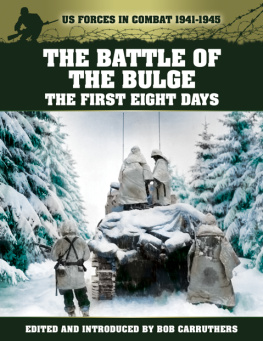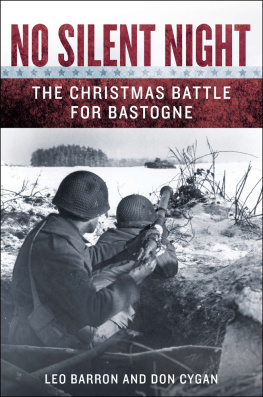USA | Canada | UK | Ireland | Australia | New Zealand | India | South Africa | China
Penguin supports copyright. Copyright fuels creativity, encourages diverse voices, promotes free speech, and creates a vibrant culture. Thank you for buying an authorized edition of this book and for complying with copyright laws by not reproducing, scanning, or distributing any part of it in any form without permission. You are supporting writers and allowing Penguin to continue to publish books for every reader.
NAL CALIBER and the C logo are trademarks of Penguin Group (USA) LLC.
Barron, Leo.
Patton at the Battle of the Bulge: how the generals tanks turned the tide at Bastogne/Leo Barron.
p. cm.
1. Ardennes, Battle of the, 19441945. 2. Patton, George S. (George Smith), 18851945 Military leadership. 3. World War, 19391945CampaignsBelgiumBastogne. I.Title.
While the author has made every effort to provide accurate telephone numbers and Internet addresses at the time of publication, neither the publisher nor the author assumes any responsibility for errors, or for changes that occur after publication. Further, publisher does not have any control over and does not assume any responsibility for author or third-party Web sites or their content.
PREFACE

T he Battle of the Bulge, fought between December 16, 1944, and January 25, 1945, was the bloodiest month in the United States Armys history. The U.S. Army in Europe sustained 77,726 casualties in December, and incurred a further 69,119 casualties in January. In December, 15,333 soldiers and airmen lost their lives, and January was not much better: An additional 12,190 soldiers and airmen perished. In total, in those two months our country sustained 146,845 casualties, and of those, 27,523 were deaths. Most of those occurred in that forty-day period when Germany and the United States were locked in the largest battle of the Western Front.
In contrast, in July 1863, the month of Gettysburg and Vicksburg, our country, both North and South, suffered 120,426 casualties combined. In fifty-one days, from May through June 1864, when the battles of the Wilderness, Spotsylvania Courthouse, and Cold Harbor raged, the butchers bill was 146,046 casualties. The only other bloodletting that came close to the Bulges total was during the forty-seven days of the Meuse-Argonne Offensive in October and November 1918, when the U.S. Army Expeditionary Force lost 122,063 men, and of those, 26,277 were deaths.
In short, the Battle of the Bulge was truly a national sacrifice, on par with the battles of Gettysburg and the Meuse-Argonne. Citizens of Belgium and Luxembourg still remember our sacrifice and annually commemorate the events of those dark days.Yet many of our own students know little about the Bulge. Their lack of historical appreciation is the number one reason why I chose this subject.
Yet it is not the only reason. The Bulge and the Siege of Bastogne are also compelling stories. When Don Cygan and I decided to publish No Silent Night: The Christmas Battle for Bastogne, I already had planned to write the sequel, because the story about Bastogne is a two-part saga. The most popular is the account about the 101st Airborne Division and its epic defense of the city. However, every story about a besieged force usually has two armies involved: the besieged and the forces sent to relieve them. Now is the time to tell the tale of Pattons 4th Armored Division and their race to relieve the paratroopers and glider men of the 101st.
Like No Silent Night, Patton at the Battle of the Bulge provides a German viewpoint to contrast with the American perspective. This story follows several German soldiers who fought with the 5th Fallschirmjger Division. Contrary to popular myth, not all German soldiers were monsters. In this book are several examples where German soldiers showed remarkable kindness and mercy toward their sworn enemies, the American army. Sadly, there are also examples of brutality, where German soldiers executed innocent Belgian civilians.
True, Belgian civilians did perish as a result of American bombs, but those bombs were not meant for the hapless civilians hiding in houses and huddling in cellars. Surgical strikes did not exist in 1944 and 1945, because bombings were far less accurate in World War II than they are today. My research revealed several incidents where Allied aircraft even strafed and bombed American tanks instead of German panzers. In the cloud of war, good intentions did not always result in accurate targeting. On the other hand, the Germans did intend to execute civilians.
Furthermore, this work provides a civilian point of view. For those living in the path of these armies, the days around Christmas were harrowing ones. In many cases, they exhibited as much amazing courage and selfless sacrifice as the soldiers and tankers who fought among them. This book is also a story about them.
In addition, I dramatize the German operational briefings, turning them into dialogues. I know some purists might balk at that technique, but I want to present an enthralling story, not a dry account. The words in the briefings are almost entirely verbatim from the sources. In many instances, all I added were quotation marks.
Patton at the Battle of the Bulge, like all good books, was a collaborative effort. I made use of several German and local accounts, for which I would like to thank Roland Gaul, who provided them, including several valuable video interviews and letters; Guy Ries and his website on Bigonville. Jrg Herzig also gave me the lengthy account of Conrad Klemment, which proved indispensable in this story. I would like to thank Ivan Steenkiste, who was crucial in supplying me with information about the battles around Chaumont. His website is a treasure trove of information.
On the American side, I would like to offer my gratitude to several individuals. Jamie Leach, the son of Jimmie Leach, was an excellent resource in regard to his father. His fathers 37th Tank Battalion radio logs, complete with notations, were a wealth of information. Rochelle Dwight gave me great material on her father, William Dwight. She still sends me hilarious daily e-mails that make me laugh. I would like to thank Robert T. Murrell, an 80th Infantry Division veteran, who helped me find information on the 318th Infantry Regiment. Andrew Adkins, the archivist for the 80th Infantry Division website, was hugely instrumental in assisting me with personnel records and personal stories from the 318th. I would like to extend my thanks to Chris Bucholtz and Lynn Gamma, who helped me with finding records concerning the 362nd Fighter Group. I would like to thank Doris Davis, an executive officer for the Veterans of the Battle of the Bulge Association. Without her help, I would have never been able to contact countless veterans and their families.




















